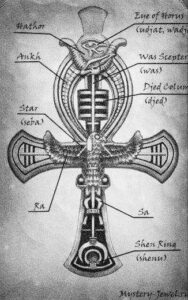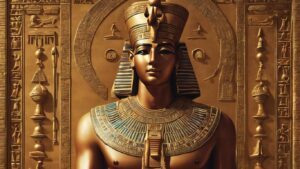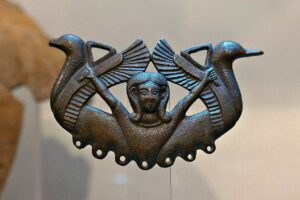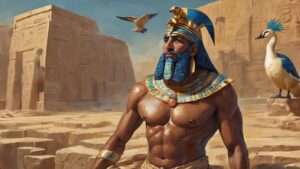Table of Contents
The ankh resembles a cross with a loop at the top, an ancient Egyptian symbol also known as the key of life or the key of the Nile. The loop at the top often symbolizes eternal life or immortality, and the cross shape represents life and death.
Ancient Egyptian art prominently featured the ankh, with gods and goddesses often holding it in depictions. Egyptian mythology and religion associate the ankh with concepts of life, death, and the afterlife. It served as an amulet or charm and was occasionally placed in tombs to ensure a prosperous afterlife for the deceased.
Today, the ankh serves as a symbol in modern contexts, worn as jewelry or used decoratively. Various cultures and belief systems beyond ancient Egypt have adopted and adapted the ankh.
Origin

The symbol’s origin traces back to ancient Egypt, where it held significant cultural and religious importance. The word “ankh” is believed to derive from the Egyptian word “nh,” meaning “life.” The symbol appears throughout ancient Egyptian history, dating back to at least the Early Dynastic Period (c. 3100–2686 BCE).
The exact origins and early development of the ankh symbol are not entirely clear. However, it closely associates with the concept of life in ancient Egyptian religious beliefs. Interpreting the loop at the top as a mirror, a sandal strap, or a stylized depiction of a human or deity holding the symbol is common.
The ankh featured prominently in religious iconography, often held by gods and goddesses in depictions on temple walls and tombs. Its significance in funerary contexts made it a crucial symbol for ensuring a positive afterlife.
Though closely linked to ancient Egypt, the ankh’s influence has extended beyond its original cultural context, persisting as a recognized symbol in various contemporary cultures and spiritual expressions.
Usage
Throughout history, the symbol served various purposes, notably in ancient Egyptian culture and later in diverse societies and belief systems:
Religious Symbolism in Ancient Egypt:
Emphasizing life, death, and the afterlife, the ankh was held by gods and goddesses in depictions.
Funerary Practices:
The ankh, placed in tombs or used as an amulet, aimed to ensure a prosperous afterlife.
Symbol of Life and Immortality:
The loop at the top symbolized eternal life and immortality.
Art and Decoration:
The ankh was a common motif in Egyptian art, appearing on temple walls, tombs, and personal items.
Amulets and Talismans:
Functioning as a protective amulet, the ankh was believed to ward off evil and bring good fortune.
Cultural and Religious Continuity:
The ankh’s enduring symbolism extended beyond ancient Egypt, finding resonance in modern belief systems.
Fashion and Popular Culture:
Adopted as a fashionable and symbolic accessory, the ankh is often worn as jewelry.
New Age and Spiritual Movements:
In contemporary spiritual practices, the ankh occasionally symbolizes life energy, balance, and spiritual awakening.
Early Dynastic and Old Kingdom Period
The Early Dynastic Period (c. 3100–2686 BCE) and the Old Kingdom Period (c. 2686–2181 BCE) represent significant phases in ancient Egyptian history:
Early Dynastic Period:
King Narmer unified Upper and Lower Egypt, symbolized by the Narmer Palette.
Memphis became the capital, and political organization characterized the period.
Early Dynastic and Old Kingdom Period:
While the symbol is strongly associated with ancient Egyptian culture, evidence of its use in the Early Dynastic and Old Kingdom Periods is not as prevalent. These periods focused on foundational developments in Egyptian civilization, with the ankh gaining prominence in later periods.
Old Kingdom Period:
Artifacts emphasized the Pharaoh’s divine role, with the ankh playing a less central role in religious iconography.
Modern Use

In modern times, the ankh has taken on new meanings and uses beyond its ancient Egyptian context:
Fashion and Jewelry: Serving as a prevalent design element, the ankh is often worn as a pendant or integrated into accessories, establishing a connection between modern aesthetics and ancient symbolism.
Tattoos: As a form of self-expression, people opt for ankh tattoos to symbolize life, spirituality, or cultural affinity, illustrating the enduring appeal of this ancient emblem in contemporary body art.
Spirituality and New Age Practices: Within spiritual communities, the ankh signifies life energy, balance, and spiritual awakening, reflecting its adaptability to evolving beliefs and practices.
Cultural Symbol: Extending beyond Egypt, the symbol finds acceptance in various cultures as a representation of life, unity, or spirituality, transcending geographical boundaries.
Literature and Art: Creatives seamlessly incorporate the ankh into their works, using its distinctive shape to convey themes of life, death, or transcendence, thereby bridging ancient symbolism with modern artistic expression.
Popular Culture: Making appearances in movies, TV shows, and music videos, the ankh’s visually striking form captivates audiences, contributing to its enduring presence in mainstream cultural expressions.
Alternative and Subcultures: Embraced by diverse subcultures, the ankh assumes multifaceted interpretations, from goth to punk, showcasing its ability to resonate with varied countercultural movements.
Personal Symbolism: When adopted as a personal emblem, the symbol becomes a representation of concepts like balance, eternity, or the interconnectedness of life and death, illustrating its capacity to hold profound meaning on an individual level.
How to activate powers?
The symbol, while historically and culturally significant, does not possess mystical powers. In ancient Egyptian belief, it was associated with life, death, and the afterlife, but traditional practices did not involve activating it in a ritualistic sense.
To incorporate the ankh into your life for symbolic or spiritual reasons, consider the following:
Personal Meditation or Reflection:
Use the ankh as a focal point for meditation, contemplating its symbolism of life and eternity.
Incorporate into Spiritual Practices:
Integrate the ankh into rituals or ceremonies as a symbol of life and connection to the divine.
Wear it as Jewelry:
Wear the ankh as a piece of jewelry for a constant reminder of its symbolism.
Art and Creativity:
Use the ankh as artistic inspiration, expressing your interpretation of its symbolism.
Symbolic Intentions:
Set personal intentions or affirmations related to the qualities you associate with the symbol.
The power of symbols lies in personal meaning, so explore how the ankh resonates with you. For deeper spiritual practices, consider traditions aligned with your interests, always approaching them with respect for their cultural and historical context.
Q&A about Ankh
What does the ankh mean?
The ankh symbolizes life, death, and the afterlife in ancient Egyptian culture. It is often associated with concepts of eternal life and immortality.
What does the ankh represent?
The ankh represents life, with its loop symbolizing immortality. It is a prominent symbol in ancient Egyptian religion and art.
How to activate the ankh?
Activating the ankh in a traditional sense is not applicable. It is a symbol, and its meaning can be contemplated, meditated upon, or incorporated into personal rituals.
What does the ankh symbolize?
The ankh symbolizes life, death, and the afterlife. Its loop is often interpreted as a symbol of eternal life, and the cross shape represents life and death.
What is the spiritual meaning of the ankh?
The spiritual meaning of the ankh varies, but it often represents life energy, balance, and a connection to the divine or eternal aspects of existence.
How to pronounce ankh?
Pronounce it as "ankh," with the "a" pronounced like the "a" in "cat."
How to get an ankh charm?
Obtain an ankh charm from jewelry stores, online retailers, or artisan markets. Choose one that resonates with you personally.
What is the meaning of the ankh word?
The word "ankh" is believed to originate from the Egyptian word "nh," meaning "life." The ankh symbolizes life and its eternal aspects.
What religion is the ankh?
The ankh is associated with ancient Egyptian religion. However, its use has transcended this context and is sometimes adopted in various spiritual and cultural expressions.
What does the Bible say about the ankh?
The Bible does not specifically mention the ankh. The symbol is not part of biblical symbolism or narratives, as it is rooted in ancient Egyptian culture and religion.




